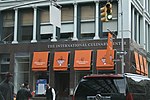African Free School
1787 establishments in New York (state)1835 disestablishments in New York (state)African-American history in New York CityAntebellum educational institutions that admitted African AmericansDefunct schools in New York City ... and 6 more
Educational institutions established in 1787Historically black schoolsHistorically segregated African-American schools in New York (state)History of New York CityPrivate elementary schools in ManhattanUnderground Railroad in New York (state)

The African Free School was a school for children of slaves and free people of color in New York City. It was founded by members of the New York Manumission Society, including Alexander Hamilton and John Jay, on November 2, 1787. Many of its alumni became leaders in the African-American community in New York.
Excerpt from the Wikipedia article African Free School (License: CC BY-SA 3.0, Authors, Images).African Free School
Lafayette Street, New York Manhattan
Geographical coordinates (GPS) Address Nearby Places Show on map
Geographical coordinates (GPS)
| Latitude | Longitude |
|---|---|
| N 40.719343 ° | E -73.9994937 ° |
Address
Lafayette Street 147
10013 New York, Manhattan
New York, United States
Open on Google Maps







